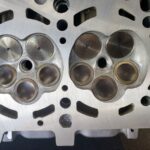Experiencing a check engine light (CEL) and encountering the P0174 Code Bank 2 can be frustrating for any car enthusiast. This code signals a lean condition on bank 2 of your engine, which, if left unaddressed, can lead to serious engine problems. In this article, we’ll delve into a real-world diagnostic case on a modified Ford GT, revealing how a seemingly straightforward P0174 code led to an unexpected culprit.
The vehicle in question, a Ford GT, had been experiencing repeated CELs and was throwing the P0174 code. This code specifically points to a lean condition in bank 2, which is typically the driver’s side of the engine. When the Powertrain Control Module (PCM) detects a lean condition – meaning there’s too much air and not enough fuel in the air-fuel mixture – its immediate reaction is to compensate by making the mixture richer. While running rich isn’t ideal, it’s a safety measure to prevent the far more damaging effects of a lean condition. In this case, the engine seemed to run fine, but the excessively rich mixture was expected to eventually foul the spark plugs.
This particular Ford GT wasn’t stock. It boasted performance modifications including a pulley and tune, an Accufab throttle body (TB), and Ford Racing Performance Parts (FRPP)/Borla long tube headers and muffler. These modifications are crucial context, as they often play a role in diagnostic puzzles.
To pinpoint the cause of the P0174 code, a systematic diagnostic approach was undertaken:
- Vacuum Leak Check with Smoke Generator: Vacuum leaks can introduce unmetered air into the system, causing a lean condition. A smoke generator helps identify any leaks in the intake system.
- Fuel Injector Flow Verification: Insufficient fuel delivery from injectors on bank 2 could also lead to a lean condition. Injector flow was checked to ensure proper fuel delivery.
- Oxygen (O2) and Mass Air Flow (MAF) Sensor Operation Verification: Faulty O2 or MAF sensors can provide incorrect readings to the PCM, leading to misdiagnoses. The operation of both sensor types was verified.
- Compression and Leak Down Tests: These tests assess the mechanical health of the engine cylinders. Low compression or excessive leak down in bank 2 could contribute to a lean condition.
- Circuit Testing from PCM to Bank 2 O2 Sensor 1: Wiring issues can disrupt sensor signals. Circuit testing ensures proper communication between the PCM and the upstream O2 sensor on bank 2.
- Visual Inspection of Exhaust Valve Springs: While less directly related, valve spring issues can sometimes impact cylinder combustion and were visually inspected.
Here’s where the modification – specifically the long tube headers – became central to the diagnosis. Understanding the difference between Original Equipment Manufacturer (OEM) exhaust manifolds and long tube headers is critical.
In the OEM configuration, the upstream O2 sensor (sensor 1) is positioned to sample the exhaust gases from all four cylinders on that bank. This provides an average reading of the air-fuel mixture for the entire bank.
However, long tube headers alter this significantly. As illustrated in the image below, with long tube headers, the upstream O2 sensor 1 is often positioned much further downstream, typically sampling exhaust gases from only one cylinder – in this case, cylinder 7 on bank 2.
This crucial difference means that while the O2 sensor is reporting conditions for cylinder 7, cylinders 5, 6, and 8 on bank 2 could be running excessively lean or rich without being detected by the sensor. This realization shifts the focus to what might be specifically affecting cylinder 7 and causing an apparent lean reading at the sensor.
To investigate further, the technician performed a clever test: swapping and rewiring the O2 sensors to effectively have sensor 1 sample from cylinder 8 instead of cylinder 7. Remarkably, with this change, the sensor voltage and air-fuel mixture readings returned to normal! This demonstrated that the issue was localized to the original O2 sensor location or cylinder 7’s exhaust stream.
The next step involved using a smoke generator again, but this time, smoke was introduced into the exhaust system itself, with rubber gloves sealing the exhaust outlets. This revealed smoke leaking from a slip-fit header connection, located very close to the original O2 sensor 1 bung on the cylinder 7 tube.
The technician deduced that the exhaust leak at the slip-fit connection was drawing in external air right at the O2 sensor. This extra air, being drawn in at the sensor location, was falsely skewing the O2 sensor reading to indicate a lean condition only at that sensor. The O2 sensor in the cylinder 8 tube, being further downstream from the slip-fit connection, was unaffected by this localized leak.
The immediate solution was to utilize the rewired O2 sensor configuration, effectively moving the sensor away from the leak’s influence. A warranty claim was pursued with Borla for the bank 2 header, hoping for a replacement to properly address the slip-fit leak.
This diagnostic journey highlights a critical takeaway, especially for those with long tube headers: don’t rely solely on the PCM to alert you to lean conditions across all cylinders, particularly on banks with modified exhaust manifolds. The altered O2 sensor positioning in long tube header setups means the PCM might only be seeing a fraction of the whole picture. While the O2 sensor placement in headers is visually apparent, the implications for diagnosing issues like a P0174 code bank 2 might not be immediately obvious.
Ultimately, this Ford GT was returned to its owner, running smoothly and CEL-free. This case serves as a valuable lesson in understanding the nuances of engine modifications and their impact on diagnostics, particularly when dealing with codes like P0174, and the importance of thorough and creative troubleshooting.
